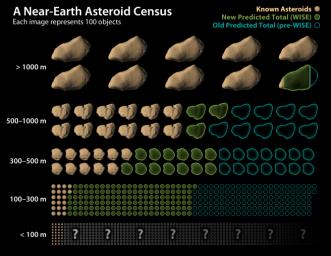WISE Revises Numbers of Asteroids Near Earth
Caption:
This chart shows how data from NASA's Wide-field Infrared Survey Explorer, or WISE, has led to revisions in the estimated population of near-Earth asteroids. The infrared-sensing telescope performed the most accurate survey to date of a slice of this population as part of project called NEOWISE. This allowed the science team to make new estimates of the total numbers of the objects in different size categories. NEOWISE observed more than 500 objects larger than 100-meters (330-feet) wide -- what can be thought of as medium to large-size asteroids. Near-Earth asteroids smaller than this size range were not studied, and near-Earth comets will be analyzed at a later time. Asteroid sizes are not drawn to scale in the chart.
Each asteroid image represents about 100 actual objects. Near-Earth asteroids that have already been found are filled in and appear brown. An entire row of asteroid images through the blue outlines shows how many total objects were thought to exist before the NEOWISE survey. The green outlines show the reduced new estimates based on the NEOWISE data.
As the graphic reveals, only a small difference was observed in the estimated total numbers of the largest asteroids -- the ones with the potential for global consequences should they impact Earth. For the medium-sized asteroids, which could still destroy a metropolitan area, new estimates predict fewer space rocks than previously thought. Details are listed below.
-- For the largest asteroids, larger than 1,000 meters (3,300 feet), NEOWISE data revises the total population down to 981 from a prior estimate of about 1,000. While this is not a dramatic difference, the findings show that NASA has met an initial near-Earth asteroid goal agreed to with Congress in 1998, calling for at least 90 percent of the largest objects to be found. There are an estimated 911 objects of this size range known, which means that NASA has found 93 percent. That leaves roughly 70 of these bodies left to find.
-- The NEOWISE data reveals an approximately 44 percent decline in the estimated numbers of medium-sized asteroids, which are defined as those objects between 100 meters and 1,000 meters (330 and 3,300 feet). Estimates now indicate about 19,500, where as 35,000 were thought to exist before.
-- The study does not apply to objects smaller than 100 meters (330 feet), but it is estimated that there are more than a million in this size range based on previous studies.
Background Info:
JPL manages the Wide-field Infrared Survey Explorer for NASA's Science Mission Directorate, Washington. The principal investigator, Edward Wright, is at UCLA. The mission was competitively selected under NASA's Explorers Program managed by the Goddard Space Flight Center, Greenbelt, Md. The science instrument was built by the Space Dynamics Laboratory, Logan, Utah, and the spacecraft was built by Ball Aerospace & Technologies Corp., Boulder, Colo. Science operations and data processing take place at the Infrared Processing and Analysis Center at the California Institute of Technology in Pasadena. Caltech manages JPL for NASA.
More information is online at
http://www.nasa.gov/wise
and
http://wise.astro.ucla.edu
.
Cataloging Keywords:
| Name |
Value |
Additional Values |
| Target |
4 Vesta |
|
| System |
Main Belt |
Near Earth Objects |
| Target Type |
Asteroid |
|
| Mission |
Near-Earth Object Wide-field Infrared Survey Explorer (NEOWISE) |
|
| Instrument Host |
NEOWISE |
|
| Host Type |
Space Telescope |
|
| Instrument |
NEOWISE Telescope |
|
| Detector |
|
|
| Extra Keywords |
Color, Impact, Infrared |
| Acquisition Date |
|
| Release Date |
2011-09-29 |
| Date in Caption |
|
|
| Image Credit |
NASA/JPL-Caltech |
| Source |
photojournal.jpl.nasa.gov/catalog/PIA14734 |
| Identifier |
PIA14734 |

 Planetary Data System
Planetary Data System
